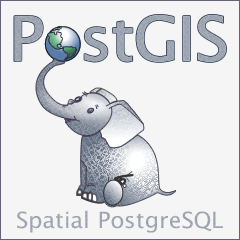The PostGIS Development Group
Abstract
PostGIS is an extension to the PostgreSQL object-relational database system which allows GIS (Geographic Information Systems) objects to be stored in the database. PostGIS includes support for GiST-based R-Tree spatial indexes, and functions for analysis and processing of GIS objects.


This is the manual for version 2.3.11
 This work is licensed under a Creative Commons Attribution-Share Alike 3.0 License.
Feel free to use this material any way you like, but we ask that you attribute credit to the PostGIS Project
and wherever possible, a link back to http://postgis.net.
This work is licensed under a Creative Commons Attribution-Share Alike 3.0 License.
Feel free to use this material any way you like, but we ask that you attribute credit to the PostGIS Project
and wherever possible, a link back to http://postgis.net.
Table of Contents
- 1. Introduction
- 2. PostGIS Installation
- 2.1. Short Version
- 2.2. Install Requirements
- 2.3. Getting the Source
- 2.4. Compiling and Install from Source: Detailed
- 2.5. Creating a spatial database using EXTENSIONS
- 2.6. Create a spatially-enabled database without using extensions
- 2.7. Installing and Using the address standardizer
- 2.8. Installing, Upgrading Tiger Geocoder and loading data
- 2.9. Create a spatially-enabled database from a template
- 2.10. Upgrading
- 2.11. Common Problems during installation
- 2.12. Loader/Dumper
- 3. PostGIS Frequently Asked Questions
- 4. Using PostGIS: Data Management and Queries
- 5. Raster Data Management, Queries, and Applications
- 5.1. Loading and Creating Rasters
- 5.2. Raster Catalogs
- 5.3. Building Custom Applications with PostGIS Raster
- 5.3.1. PHP Example Outputting using ST_AsPNG in concert with other raster functions
- 5.3.2. ASP.NET C# Example Outputting using ST_AsPNG in concert with other raster functions
- 5.3.3. Java console app that outputs raster query as Image file
- 5.3.4. Use PLPython to dump out images via SQL
- 5.3.5. Outputting Rasters with PSQL
- 6. Using PostGIS Geometry: Building Applications
- 7. Performance tips
- 8. PostGIS Reference
- 8.1. PostgreSQL PostGIS Geometry/Geography/Box Types
- 8.2. PostGIS Grand Unified Custom Variables (GUCs)
- 8.3. Management Functions
- 8.4. Geometry Constructors
- 8.5. Geometry Accessors
- 8.6. Geometry Editors
- 8.7. Geometry Outputs
- 8.8. Operators
- 8.9. Spatial Relationships and Measurements
- 8.10. SFCGAL Functions
- 8.11. Geometry Processing
- 8.12. Linear Referencing
- 8.13. Temporal Support
- 8.14. Long Transactions Support
- 8.15. Miscellaneous Functions
- 8.16. Exceptional Functions
- 9. Raster Reference
- 9.1. Raster Support Data types
- 9.2. Raster Management
- 9.3. Raster Constructors
- 9.4. Raster Accessors
- 9.5. Raster Band Accessors
- 9.6. Raster Pixel Accessors and Setters
- 9.7. Raster Editors
- 9.8. Raster Band Editors
- 9.9. Raster Band Statistics and Analytics
- 9.10. Raster Outputs
- 9.11. Raster Processing
- 9.12. Raster Operators
- 9.13. Raster and Raster Band Spatial Relationships
- 10. PostGIS Raster Frequently Asked Questions
- 11. Topology
- 11.1. Topology Types
- 11.2. Topology Domains
- 11.3. Topology and TopoGeometry Management
- 11.4. Topology Constructors
- 11.5. Topology Editors
- 11.6. Topology Accessors
- 11.7. Topology Processing
- 11.8. TopoGeometry Constructors
- 11.9. TopoGeometry Editors
- 11.10. TopoGeometry Accessors
- 11.11. TopoGeometry Outputs
- 11.12. Topology Spatial Relationships
- 12. Address Standardizer
- 13. PostGIS Extras
- 14. PostGIS Special Functions Index
- 14.1. PostGIS Aggregate Functions
- 14.2. PostGIS Window Functions
- 14.3. PostGIS SQL-MM Compliant Functions
- 14.4. PostGIS Geography Support Functions
- 14.5. PostGIS Raster Support Functions
- 14.6. PostGIS Geometry / Geography / Raster Dump Functions
- 14.7. PostGIS Box Functions
- 14.8. PostGIS Functions that support 3D
- 14.9. PostGIS Curved Geometry Support Functions
- 14.10. PostGIS Polyhedral Surface Support Functions
- 14.11. PostGIS Function Support Matrix
- 14.12. New, Enhanced or changed PostGIS Functions
- 14.12.1. PostGIS Functions new or enhanced in 2.3
- 14.12.2. PostGIS Functions new or enhanced in 2.2
- 14.12.3. PostGIS functions breaking changes in 2.2
- 14.12.4. PostGIS Functions new or enhanced in 2.1
- 14.12.5. PostGIS functions breaking changes in 2.1
- 14.12.6. PostGIS Functions new, behavior changed, or enhanced in 2.0
- 14.12.7. PostGIS Functions changed behavior in 2.0
- 14.12.8. PostGIS Functions new, behavior changed, or enhanced in 1.5
- 14.12.9. PostGIS Functions new, behavior changed, or enhanced in 1.4
- 14.12.10. PostGIS Functions new in 1.3
- 15. Reporting Problems
- A. Appendix
- A.1. Release 2.3.11
- A.2. Release 2.3.10
- A.3. Release 2.3.9
- A.4. Release 2.3.8
- A.5. Release 2.3.7
- A.6. Release 2.3.6
- A.7. Release 2.3.5
- A.8. Release 2.3.4
- A.9. Release 2.3.3
- A.10. Release 2.3.2
- A.11. Release 2.3.1
- A.12. Release 2.3.0
- A.13. Release 2.2.2
- A.14. Release 2.2.1
- A.15. Release 2.2.0
- A.16. Release 2.1.8
- A.17. Release 2.1.7
- A.18. Release 2.1.6
- A.19. Release 2.1.5
- A.20. Release 2.1.4
- A.21. Release 2.1.3
- A.22. Release 2.1.2
- A.23. Release 2.1.1
- A.24. Release 2.1.0
- A.25. Release 2.0.5
- A.26. Release 2.0.4
- A.27. Release 2.0.3
- A.28. Release 2.0.2
- A.29. Release 2.0.1
- A.30. Release 2.0.0
- A.31. Release 1.5.4
- A.32. Release 1.5.3
- A.33. Release 1.5.2
- A.34. Release 1.5.1
- A.35. Release 1.5.0
- A.36. Release 1.4.0
- A.37. Release 1.3.6
- A.38. Release 1.3.5
- A.39. Release 1.3.4
- A.40. Release 1.3.3
- A.41. Release 1.3.2
- A.42. Release 1.3.1
- A.43. Release 1.3.0
- A.44. Release 1.2.1
- A.45. Release 1.2.0
- A.46. Release 1.1.6
- A.47. Release 1.1.5
- A.48. Release 1.1.4
- A.49. Release 1.1.3
- A.50. Release 1.1.2
- A.51. Release 1.1.1
- A.52. Release 1.1.0
- A.53. Release 1.0.6
- A.54. Release 1.0.5
- A.55. Release 1.0.4
- A.56. Release 1.0.3
- A.57. Release 1.0.2
- A.58. Release 1.0.1
- A.59. Release 1.0.0
- A.60. Release 1.0.0RC6
- A.61. Release 1.0.0RC5
- A.62. Release 1.0.0RC4
- A.63. Release 1.0.0RC3
- A.64. Release 1.0.0RC2
- A.65. Release 1.0.0RC1